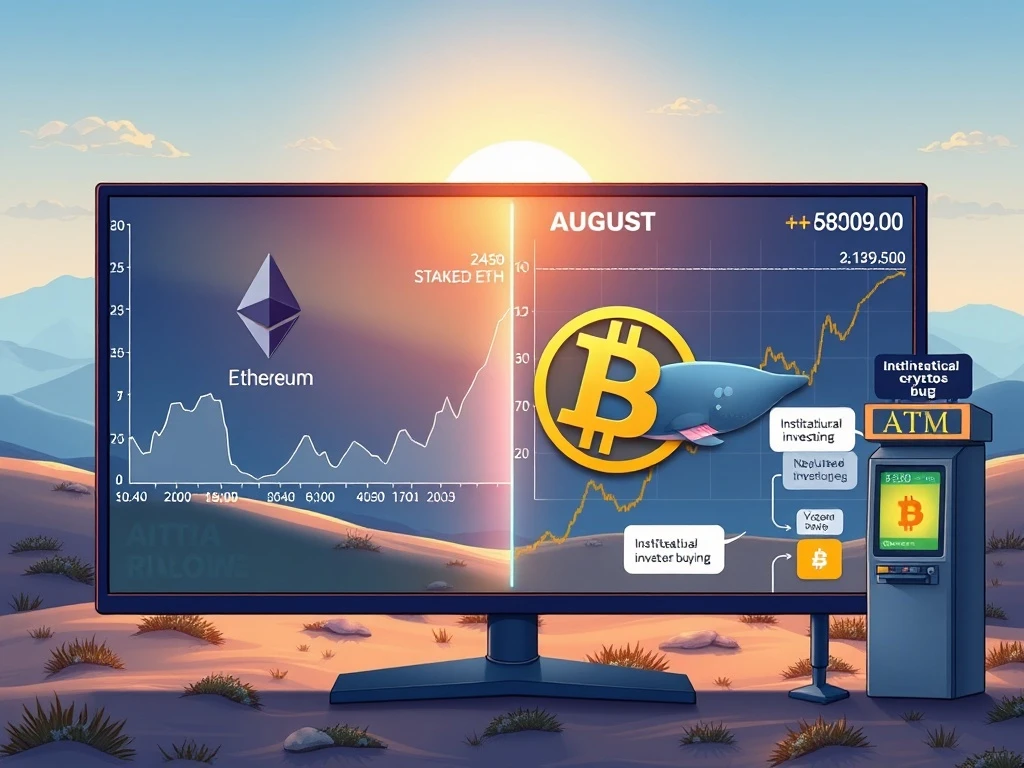August Crypto Market: Ethereum Soars to 1.8M Transactions, Bitcoin Whale Sparks $2.7B Meltdown

The August crypto market unfolded with a mix of groundbreaking achievements and significant challenges. For those keenly watching the digital asset space, this month delivered a compelling narrative. Ethereum, for instance, showcased remarkable strength, hitting a year-high in transaction volume. Meanwhile, Bitcoin experienced a dramatic event, involving a substantial whale sale that sent ripples across the market. This comprehensive recap delves into these pivotal moments, offering insights into regulatory shifts, institutional moves, and persistent security concerns.
Ethereum Transactions Reach New Heights Amid Staking Surge
The Ethereum network truly shone in August, demonstrating robust growth and increased activity. On August 5, the blockchain processed an astonishing 1.8 million transactions, marking a one-year high. This surge underscores the network’s increasing utility and adoption. Furthermore, the amount of Ether (ETH) locked into staking protocols reached unprecedented levels. Nearly 30% of the entire Ether supply is now staked, signaling strong investor confidence and a long-term outlook.
Many investors choose to stake their ETH, preferring to earn rewards rather than selling their holdings. This commitment to staking helps secure the network and reduces the circulating supply, potentially impacting future price movements. Significantly, the U.S. Securities and Exchange Commission (SEC) recently issued guidance on liquid staking. This move sparked speculation that an Ethereum ETF with staking capabilities could soon gain approval, which analysts believe would dramatically reshape the market dynamics for ETH.
The Impact of a Bitcoin Whale Meltdown
While Ethereum celebrated new highs, Bitcoin faced a period of volatility. On August 24, a single Bitcoin whale executed a massive sale, offloading 24,000 BTC. This transaction was valued at approximately $2.7 billion. Consequently, the crypto market experienced a flash crash, leading to significant liquidations. Reports from QCP indicate that around $500 million in leveraged positions were wiped out within minutes following this sudden market shift.
Before this dramatic event, Bitcoin had traded within a relatively narrow range. However, the whale sale caused Bitcoin dominance to slip, moving from 60% to 57% in August. While still considerably higher than during the 2021 altcoin season, this shift is noteworthy. Analysts from QCP suggest that if Ether ETFs with staking receive approval, this could fuel the narrative that ETH is poised to outperform BTC in the near future. This development highlights the interconnected and often unpredictable nature of the top cryptocurrencies.
Stricter Regulations for Crypto ATMs
Regulatory scrutiny around cryptocurrency infrastructure continued to intensify in August, particularly concerning crypto ATMs. Rhode Island and Wisconsin both introduced new legislation regulating these kiosks. These additions bring the total number of U.S. states with such rules to 13. Furthermore, some municipalities, including Stillwater, Minnesota, and Spokane, Washington, have taken even stricter measures, banning crypto ATMs outright within their jurisdictions.
The primary motivation behind these regulations is to combat fraud. Scammers frequently exploit these machines, often targeting senior citizens who may be less familiar with new technologies like Bitcoin and other cryptocurrencies. The American Association of Retired Persons (AARP), a prominent advocacy group for individuals aged 50 and over, has actively supported and guided the drafting of many of these state laws. This collaboration underscores a growing focus on consumer protection within the rapidly evolving digital asset space.
Institutional Bitcoin Adoption Continues Strong
Despite market fluctuations, institutional interest in Bitcoin remained robust throughout August. Two prominent firms, known for their corporate treasury strategies, significantly increased their holdings. Strategy, a trendsetting company in the Bitcoin treasury movement, acquired an additional 3,511 BTC. With Bitcoin averaging around $116,000 in August, this purchase amounted to approximately $407.2 million for the month.
Similarly, Japanese investment company Metaplanet also expanded its Bitcoin reserves. The firm scooped up 1,859 BTC, representing a total investment of just over $215.6 million based on the same average price. These substantial acquisitions by leading companies reinforce the ongoing trend of institutional Bitcoin adoption. They demonstrate a continued belief in Bitcoin’s long-term value as a strategic asset, even amidst short-term market volatility.
Persistent Threats: DeFi Exploits and Security Challenges
The decentralized finance (DeFi) sector unfortunately continued to grapple with security vulnerabilities in August. Data from DefiLlama revealed that cybercriminals successfully stole $53 million through various DeFi exploits during the month. The largest incident involved a $48 million hack targeting BtcTurk, a Turkish cryptocurrency exchange. This single event accounted for the vast majority of the month’s stolen funds.
The crypto industry consistently makes concerted efforts to enhance security and prevent such breaches. However, the battle against malicious actors remains challenging. Ronghui Gu, a computer science professor at Columbia University and co-founder of blockchain security platform CertiK, articulated this struggle during a Crypto News Insights Chain Reaction live show. He stated, “It’s an endless war” between hackers and security experts, highlighting the continuous need for vigilance and innovation in cybersecurity within the digital asset ecosystem.
Bitcoin’s Growing Share in the Global Money Supply
A significant report released by Bitcoin financial services company River in August highlighted Bitcoin’s expanding presence in the global financial landscape. The study concluded that Bitcoin now accounts for an impressive 1.7% of the global money supply. River reached this figure by comparing Bitcoin’s market capitalization against a basket of fiat currencies totaling $112.9 trillion and $25.1 trillion in hard money, excluding silver, platinum, and exotic metals.
The report assumed a Bitcoin market capitalization of $2.4 trillion for its calculations. At the time of this article’s publishing, BTC’s market cap stood at approximately $2.21 trillion, which would place Bitcoin’s share of global money closer to 1.6%. Nevertheless, this growing percentage signifies Bitcoin’s increasing relevance and its potential to become a more integral part of the world’s financial system. It reflects a steady march towards broader mainstream adoption and recognition as a legitimate store of value.
Conclusion: A Dynamic August Crypto Market
August presented a dynamic and multifaceted picture for the August crypto market. Ethereum demonstrated remarkable strength with record-breaking transaction volumes and a surge in staked ETH, signaling robust network health and investor confidence. Conversely, Bitcoin experienced a significant jolt from a large whale sale, which led to a flash crash and a dip in market dominance. Meanwhile, regulatory bodies continued their work, implementing stricter controls on crypto ATMs to protect consumers from fraud.
On the institutional front, major players like Strategy and Metaplanet reinforced their commitment to Bitcoin through substantial purchases, underscoring continued corporate adoption. However, the persistent threat of DeFi exploits highlighted the ongoing security challenges within the industry. Finally, Bitcoin’s increasing share of the global money supply indicated its growing significance in the broader financial ecosystem. These diverse developments collectively paint a picture of a maturing yet still highly volatile and evolving digital asset landscape.







